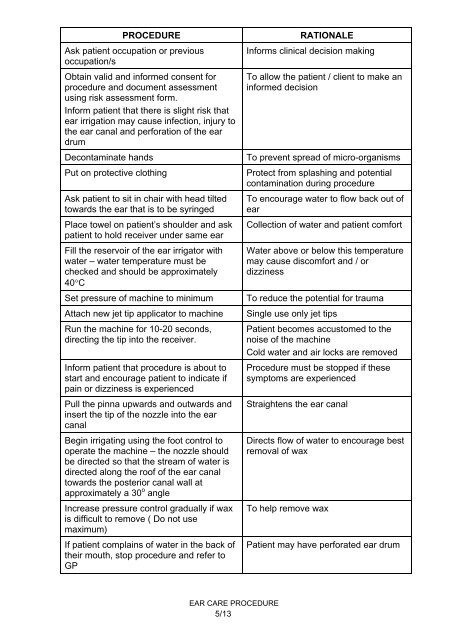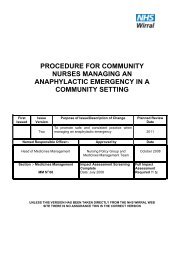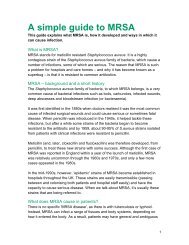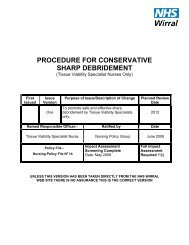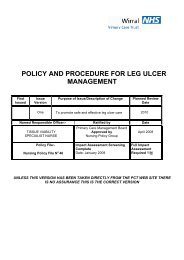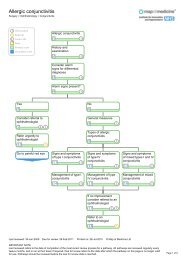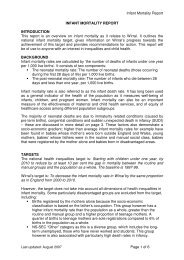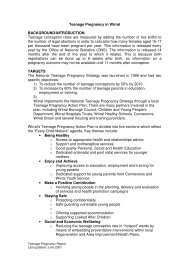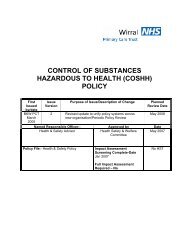EAR CARE PROCEDURE FOR COMMUNITY NURSING SERVICES
EAR CARE PROCEDURE FOR COMMUNITY NURSING SERVICES
EAR CARE PROCEDURE FOR COMMUNITY NURSING SERVICES
You also want an ePaper? Increase the reach of your titles
YUMPU automatically turns print PDFs into web optimized ePapers that Google loves.
<strong>PROCEDURE</strong><br />
Ask patient occupation or previous<br />
occupation/s<br />
Obtain valid and informed consent for<br />
procedure and document assessment<br />
using risk assessment form.<br />
Inform patient that there is slight risk that<br />
ear irrigation may cause infection, injury to<br />
the ear canal and perforation of the ear<br />
drum<br />
Decontaminate hands<br />
Put on protective clothing<br />
Ask patient to sit in chair with head tilted<br />
towards the ear that is to be syringed<br />
Place towel on patient’s shoulder and ask<br />
patient to hold receiver under same ear<br />
Fill the reservoir of the ear irrigator with<br />
water – water temperature must be<br />
checked and should be approximately<br />
40°C<br />
Set pressure of machine to minimum<br />
Attach new jet tip applicator to machine<br />
Run the machine for 10-20 seconds,<br />
directing the tip into the receiver.<br />
Inform patient that procedure is about to<br />
start and encourage patient to indicate if<br />
pain or dizziness is experienced<br />
Pull the pinna upwards and outwards and<br />
insert the tip of the nozzle into the ear<br />
canal<br />
Begin irrigating using the foot control to<br />
operate the machine – the nozzle should<br />
be directed so that the stream of water is<br />
directed along the roof of the ear canal<br />
towards the posterior canal wall at<br />
approximately a 30 o angle<br />
Increase pressure control gradually if wax<br />
is difficult to remove ( Do not use<br />
maximum)<br />
If patient complains of water in the back of<br />
their mouth, stop procedure and refer to<br />
GP<br />
RATIONALE<br />
Informs clinical decision making<br />
To allow the patient / client to make an<br />
informed decision<br />
To prevent spread of micro-organisms<br />
Protect from splashing and potential<br />
contamination during procedure<br />
To encourage water to flow back out of<br />
ear<br />
Collection of water and patient comfort<br />
Water above or below this temperature<br />
may cause discomfort and / or<br />
dizziness<br />
To reduce the potential for trauma<br />
Single use only jet tips<br />
Patient becomes accustomed to the<br />
noise of the machine<br />
Cold water and air locks are removed<br />
Procedure must be stopped if these<br />
symptoms are experienced<br />
Straightens the ear canal<br />
Directs flow of water to encourage best<br />
removal of wax<br />
To help remove wax<br />
Patient may have perforated ear drum<br />
<strong>EAR</strong> <strong>CARE</strong> <strong>PROCEDURE</strong><br />
5/13


